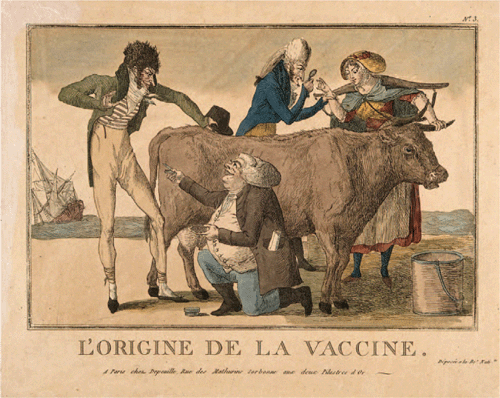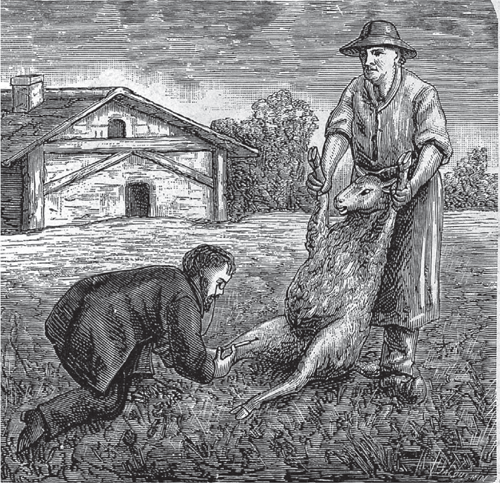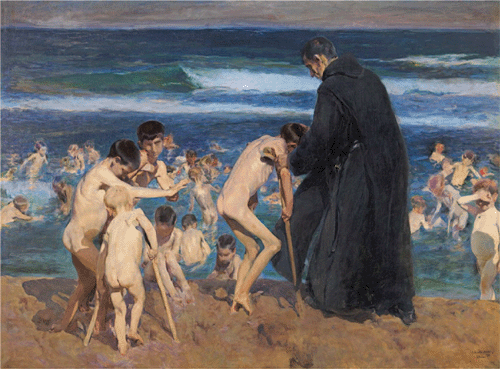What history teaches us about vaccines and pandemics
David IsaacsA Children’s Hospital at Westmead Westmead, NSW 2145, Australia;
B University of Sydney, Sydney, NSW 2006, Australia. Email: david.isaacs@health.nsw.gov.au
Microbiology Australia 41(4) 168-171 https://doi.org/10.1071/MA20046
Published: 28 October 2020
Abstract
The history of immunisation is full of heroes but also full of villains, and our successes are tempered by tragedies. Despite the urgent need for a vaccine against SARS-CoV-2, we should not neglect the lessons of history. These include ethical issues relating to vaccine safety, such as the possible risks of vaccine-induced enhancement witnessed with dengue vaccine in the Philippines, and how our decisions may be represented by the anti-vaxx movement.
Nature is the world’s greatest terrorist1. Any doubt about the veracity of this pithy aphorism, shamelessly purloined from an inspirational lecture by Nobel laureate Sir Peter Doherty, has been put to rest by COVID-192,3, a pandemic better understood through an historical lens of vaccines and pandemics.
The Greek historian Thucydides, who survived catching ‘the plague of Athens’ during the Peloponnesian War 2400 years ago, described the devastating epidemic of what may have been typhus or bubonic plague which killed 100 000 Athenians and led to the defeat of Athens by Sparta.1 Thucydides also recognised that survivors like himself were protected against catching the disease again, the first recorded description of the concept of immunity.1
Smallpox has been recognised as a human scourge since Egyptian times4. Smallpox devastated Indigenous populations in Central and South America and in Australia (where a horrific 1789 outbreak among the Aboriginal people living around Sydney Harbour may have been deliberately introduced by the First Fleet5). Smallpox survivors were often blinded or suffered terrible facial scarring. In 1950, smallpox infected 50 million people and killed 10 million1,4. By 1978, immunisation had eradicated smallpox, undoubtedly one of humanity’s greatest ever achievements.
Variolation, inoculation of smallpox scabs nasally using a blowpipe in 15th century China, or dermally elsewhere in India, Asia, Africa and Europe, is the oldest known human form of immunisation6. Variolation was introduced into the UK from Turkey by Lady Mary Wortley Montague, feminist wife of the British Ambassador to Turkey. However, variolation could cause smallpox, not infrequently killing the recipient6.
The history of vaccines is full of fascinating figures, often with moral flaws, because we are all only human. Edward Jenner was a Gloucestershire country general practitioner. He had prestige as a Fellow of the Royal Society awarded, not for his work on smallpox, but for describing the groove in cuckoo chicks’ back used to evict other birds’ eggs from their nest. Jenner himself was variolated aged 8. Jenner variolated a large number of people in his parish. Some developed mild smallpox, some severe, but a small number developed no rash. From his records, Jenner noted all those who developed no rash had previously had cowpox. Some were milkmaids or had caught cowpox from milkmaids (Figure 1). Jenner knew the folklore that milkmaids were characteristically unmarked by smallpox scars. In a traditional poem, a soldier courts a milkmaid:

|
‘Where are you going to, my pretty maid?’
‘I’m going to market, sir’ she said.
‘What is your fortune, my pretty maid?’
‘My face is my fortune, sir’, she said.
‘Then I cannot marry you, my pretty maid’.
‘Nobody asked you, sir’ she said.
Good for her.
We should hesitate to judge erstwhile experiments by modern standards, but Jenner’s seminal experiment is ethically challenging. In 1796, Jenner famously lanced cowpox vesicles on the hand of milkmaid Sarah Nelmes, then injected cowpox into two small cuts he made in the arm of 8-year-old James Phipps (the son of Jenner’s labourer-gardener). Six weeks later, Jenner inoculated James with material taken from a smallpox victim. Thankfully James survived this challenge…and the more than 20 subsequent times Jenner injected poor James with smallpox material. Jenner was a cautious man, although perhaps more concerned about scientific proof than poor James’ welfare.
Jenner presented a paper on James Phipps to the Royal Society in 17981. Within two years Jenner’s vaccine was being used around the world. Catherine the Great named the first vaccinated Russian child Vaccinov; the state paid for his education. There was vigorous opposition from anti-immunisation movements, particularly after 1853 when the British Government questionably made infant smallpox immunisation compulsory. In 1885, 80 000 people marched through Leicester carrying banners, an effigy of Jenner and a child’s coffin. Opposition in North America was also fierce but more litigious. However, as records and public health improved, it became clear that smallpox vaccine worked. In 1967, the World Health Organization (WHO) introduced an ambitious new Intensified Smallpox Eradication Programme trying to eliminate smallpox. Major contributors included Donald Ainslie (DA) Henderson (1928–2016) and the late great Australian virologist Sir Frank Fenner (1914–2010)1,7. That year, 1967, an estimated 10–15 million people globally contracted smallpox and two million died. Eleven years later, none did.
Louis Pasteur, another giant of vaccines, was also a country boy, one who preferred fishing and drawing to study1,8. Louis witnessed wolf attacks in rural France, and his playmates’ agonised screams as the blacksmith cauterised their wounds. Pasteur swore he would prevent rabies. He would succeed, but took a strange path, becoming Professor of Chemistry and then Professor of Physics at the University of Strasbourg, but never a doctor or microbiologist.
Pasteur was the first scientist to describe the phenomenon of attenuation, initially through serendipity. Chicken cholera could wipe out a flock in 3 days. Pasteur identified and cultured the cholera bacillus. Inoculated bacillus killed chickens rapidly. Pasteur left Paris one summer to escape the heat, leaving his cultures on the laboratory shelf. On his return he found that if he inoculated chickens with the stored cultures they stayed healthy. If he then challenged them with fresh bacillus they survived, whereas the fresh bacillus was fatal to naive chickens. Attenuated bacillus protected them. Not famed for false modesty, Pasteur said: ‘In the fields of observation, chance favours only the prepared mind’. Recognising that attenuation had parallels with Jenner’s earlier use of cowpox (vacca is Latin for cow), Pasteur coined the name ’vaccination’ in honour of Jenner.
Pasteur developed a vaccine against anthrax. In 1882, he accepted a challenge to prove its efficacy, conducting a remarkable, controlled field trial. Pasteur gave 25 sheep his anthrax vaccine; 25 controls had no vaccine. Weeks later he challenged them by injecting live anthrax on a Parisian hillside watched by a huge crowd (Figure 2). The Press including the London Times reported daily. After two days, all 25 controls died and all 25 vaccinated sheep survived. In the next ten years, 3 500 000 sheep and 500 000 cattle were vaccinated against anthrax, with over 99% survival. Mass immunisation was born.

|
In 1888, Pasteur sent his nephew Dr Adrien Loir by steamer to Australia to make and sell anthrax vaccine [the word nepotism derives from the Italian nipotini for nephews, referring to the Popes who called their illegitimate sons their ‘nephews’]. Loir successfully repeated Pasteur’s field trial on 39 sheep and four cows in Junee Junction in country NSW. Incidentally, Loir also found time to have a fling with French actor Sarah Bernhardt who was touring Australia1.
Pasteur and Dr Émile Roux attenuated rabies virus by repeated passage through preparations of rabbit spinal cord. Their live attenuated rabies vaccine was safe and effective in dogs (although a posthumous analysis of Pasteur’s notebooks showed he ‘exaggerated’ the number of dogs tested)1,9. In 1885, Roux immunised 9-year-old Joseph Meister, bitten 14 times by a rabid dog. Joseph survived and became caretaker at the Pasteur Institute. Pasteur was sometimes economical with scientific truth, and secretly used the work of other colleagues like Émile Roux without acknowledgement. But Louis Pasteur was a genius; we owe him as great a debt as we do to Edward Jenner for the development of the vaccines we use today.
The 20th century was the golden age of immunisation1. Microbiologists led the way. In 1884, Klebs and Löffler described Corynebacterium diphtheriae; in 1888, Émile Roux and Alexandre Yersin showed that a filtrate of C. diphtheriae caused diphtheria-like disease when injected into laboratory animals. Inactivating this diphtheria toxin led to diphtheria toxoid vaccine. The first human diphtheria toxoid vaccine was developed in 1923, the first tetanus toxoid vaccine just a year later. Routine childhood immunisation started in the early 1940s in Australia using diphtheria and tetanus toxoid vaccines (DT). In 1949, they were combined with a whole-cell pertussis vaccine made using killed Bordetella pertussis, to make DTP, the ‘triple vaccine’1.
The history of polio vaccine development is a book of its own. Polioviruses caused fatal or crippling infections in children and young adults (Figure 3). In the USA, two Jewish refugees Albert Sabin and Jonas Salk competed to develop live oral (OPV) and killed injected vaccines (IPV), respectively. US President Franklin Delano Roosevelt, permanently wheelchair-bound after contracting polio as a young father, started the March of Dimes to fund vaccine development. The March of Dimes funded a successful trial of IPV involving two million ‘Polio Pioneer’ children. In 1955, four US companies gained the tender to manufacture Salk’s killed vaccine. One of them, a small family-based Californian firm, Cutter Laboratories, did not inactivate poliovirus effectively. Over 200 000 children received the Cutter vaccine, 40 000 developed polio, 200 were paralysed permanently and 10 died1,10. Despite the ‘Cutter Incident’, polio was so feared that the IPV programme soon resumed. Meanwhile the USSR adopted Sabin’s OPV. OPV became the main vaccine used in developing countries, with such success that paralytic polio cases fell from 350 000 globally in 1988 to 33 in 20181.

|
Anti-vaxxers say vaccines can cause cancer. On the contrary, hepatitis B vaccine prevents liver cancer, while human papillomavirus vaccine (HPV), a novel virus-like particle developed by Ian Frazer and Jian Zhou at the University of Queensland, prevents cervical cancer11.
We are fortunate to live in a golden age of immunisation. Australian children are routinely immunised against 13 major infections. Mortality and morbidity in the elderly has been reduced with vaccines against influenza, pneumococcus and zoster. Vaccines are available to protect travellers. We are privileged to be so well protected against diseases that ravaged our ancestors.
The urgent need for a vaccine against SARS-CoV-2 should not lead us to neglect the lessons of history about vaccine safety, such as the possible risks of vaccine-induced enhancement witnessed with dengue vaccine in the Philippines12. Nor should we neglect our ethical obligation to distribute any SARS-CoV-2 vaccine as equitably as possible, recognising that the poorest people of the world are those at greatest risk from COVID-19 with the fewest resources to treat infection.
Conflicts of interest
The author declares no conflicts of interest.
Acknowledgements
This research did not receive any specific funding.
References
[1] Isaacs, D. (2019) Defeating the Ministers of Death: The Compelling History of Vaccination. HarperCollins, Sydney.[2] Isaacs, D. et al. (2020) Ethical reflections on the COVID-19 pandemic: the epidemiology of panic. J. Paediatr. Child Health 56, 690–691.
| Ethical reflections on the COVID-19 pandemic: the epidemiology of panic.Crossref | GoogleScholarGoogle Scholar | 32406543PubMed |
[3] Isaacs, D. et al. (2020) Apocalypse perhaps. J. Paediatr. Child Health 56., .
| Apocalypse perhaps.Crossref | GoogleScholarGoogle Scholar | 33099829PubMed |
[4] Hopkins, D.R. (1983) Princes and Peasants: Smallpox in History. University of Chicago Press, Chicago, IL, USA.
[5] Warren, C. (2014) Smallpox at Sydney Cove – who, when, why? J. Austral. Stud. 38, 68–86.
[6] Boyston, A. (2012) The origins of inoculation. J. Roy. Soc. Med. 105, 309–13.
[7] Fenner, F. et al. (1988) Smallpox and its eradication. History of international public health, no. 6. World Health Organization, Geneva, Switzerland.
[8] Debré, P. (2000) Louis Pasteur. Translated by Elborg Forster. JHU Press, Baltimore, MD, USA.
[9] Geison, G.L. (1995) The Private Science of Louis Pasteur. Princeton University Press, Princeton, NJ, USA.
[10] Offit, P. (2005) The Cutter Incident – How America’s First Polio Vaccine Led to the Growing Vaccine Crisis. Yale University Press, New Haven, CT, USA.
[11] Arbyn, M. et al. (2018) Prophylactic vaccination against human papillomaviruses to prevent cervical cancer and its precursors. Cochrane Database Syst. Rev. 5, CD009069.
| Prophylactic vaccination against human papillomaviruses to prevent cervical cancer and its precursors.Crossref | GoogleScholarGoogle Scholar | 29740819PubMed |
[12] Arkin, F. (2019) Dengue vaccine fiasco leads to criminal charges for researcher in the Philippines. Science. https://www.sciencemag.org/news/2019/04/dengue-vaccine-fiasco-leads-criminal-charges-researcher-philippines (accessed 3 August 2020).
Biography
Professor David Isaacs is a paediatric infectious disease specialist at the Children’s Hospital at Westmead and the University of Sydney. David has an identical twin brother, Stephen, who is a child psychiatrist. They went to different schools and once swapped schools for a day. David trained in London, Sydney and Oxford, moving permanently to Sydney in 1989 to head a Department of Immunology and Infectious Diseases at the Children’s Hospital. He was the only member of the Department. He loves writing and has written letters to his twin every week for 30 years and editorials for the Journal of Paediatrics and Child Health every month for 10 years. He is the author of Defeating the Ministers of Death. The Compelling History of Vaccination, reviewed in this issue.


